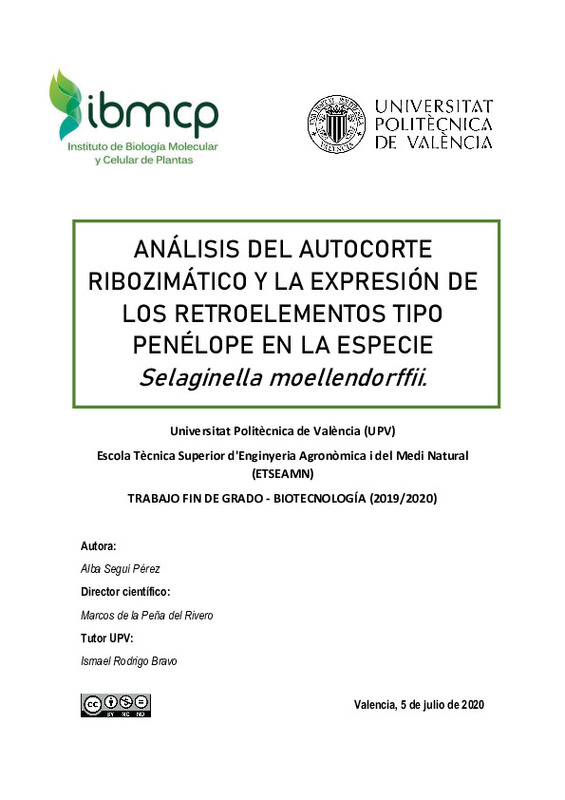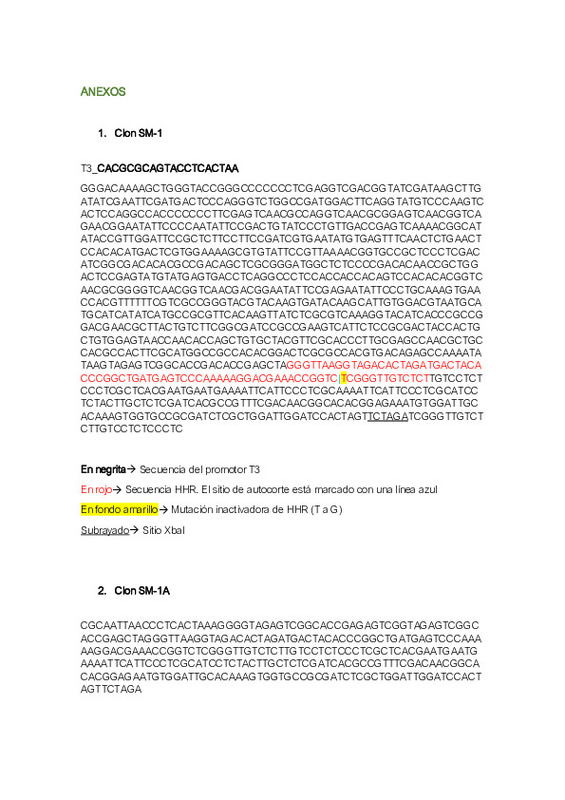|
Resumen:
|
[ES] A principio de los años 80 se descubrieron unas moléculas catalíticas cuyo centro activo estaba compuesto completamente por RNA y que se denominaron RNAs catalíticos o ribozimas. Desde su descubrimiento hasta ahora ...[+]
[ES] A principio de los años 80 se descubrieron unas moléculas catalíticas cuyo centro activo estaba compuesto completamente por RNA y que se denominaron RNAs catalíticos o ribozimas. Desde su descubrimiento hasta ahora se han producido muchos avances en este campo que han permitido descubrir diferentes tipos de ribozimas. Entre las ribozimas naturales conocidas, el grupo más numeroso es el de las pequeñas ribozimas de autocorte. Dentro de este grupo, destacan las ribozimas cabeza de martillo o hammerhead (HHR), las primeras en describirse y probablemente las mejor estudiadas. Datos previos a este trabajo indican que las HHR se encuentran distribuidas en multitud de genomas a lo largo de toda la escala biológica. Además, muchos de estos motivos catalíticos se han encontrado con frecuencia en elementos genéticos móviles como son los retrotransposones. En este proyecto se ha trabajado con una primitiva planta vascular, Selaginella moellendorffii, cuyo genoma contiene retrotransposones de la familia de elementos similares a Penélope (PLEs), que se caracterizan por contener en su secuencia ribozimas de cabeza de martillo.
Para poder conocer el funcionamiento y las características de los transposones PLE y sus ribozimas en S. moellendorffii, se comprobó inicialmente el poder de autoescisión de dichas ribozimas. Para ello, primero se clonaron en plásmidos varios fragmentos del retrotransposón incluyendo la secuencia de la ribozima HHR. A continuación, se realizaron diversos ensayos de autocorte bajo diferentes condiciones (co-transcripcionales, post-transcripcionales, diversos tiempos de incubación¿) para comprobar la eficiencia catalítica de la ribozima. Los resultados obtenidos in vitro mostraron muy bajas tasas de autocorte de la HHR. Estudios previos apuntaban que las ribozimas de los elementos PLE se disponen como dímeros en tándem. Esta disposición concreta y los resultados obtenidos de baja escisión de manera individual refuerzan la idea de que las ribozimas de los elementos Penélope de S. moellendorffii funcionarían más eficientemente como dímeros. Por tanto, futuros pasos en la investigación de las ribozimas en elementos PLE de S. moellendorffii consistirán en la realización de construcciones diméricas, de las cuales se esperan mayores tasas de escisión.
Por otro lado, en este estudio también se comprobó si los elementos Penélope se estaban expresando en planta. Para ello, se extrajo RNA total de plantas de S. moellendorffii y se realizaron ensayos de hibridación Northern usando sondas marcadas con digoxigenina. Mediante estos estudios se comprobó la existencia de una banda de RNA del tamaño esperado para el elemento PLE de S. moellendorffii (~5 kb), lo que sugiere que este elemento transponible realmente se podría estar expresando en la planta. Para completar esta línea de trabajo, será necesario comprobar la amplificación por RT-PCR del RNA detectado por análisis Northern.
La elucidación de las tasas de escisión y del funcionamiento de ribozimas que se encuentran en organismos como S. moellendorffii proporciona las bases necesarias para poder comprender el funcionamiento de estos motivos en los genomas de multitud de especies. Con este conocimiento se podrá utilizar con mayor precisión ribozimas artificiales capaces de escindir secuencias específicas. Tanto las ribozimas naturales como las nuevas ribozimas creadas son cada vez más utilizadas en terapia génica para tener un control de la expresión genética.
[-]
[EN] At the beginning of the 80s, catalytic molecules whose active centre was composed entirely of RNA were discovered and were called catalytic RNAs or ribozymes. Since their discovery until now, many advances have been ...[+]
[EN] At the beginning of the 80s, catalytic molecules whose active centre was composed entirely of RNA were discovered and were called catalytic RNAs or ribozymes. Since their discovery until now, many advances have been made in this field that have led to the discovery of different types of ribozymes. Among the known natural ribozymes, the most numerous group is the small self-cleaving ribozymes. Within this group, hammerhead ribozymes (HHR) stand out, the first to be described and probably the best studied. Previous data indicate that hammerhead ribozymes are distributed in multitude of genomes throughout the biological scale. Furthermore, many of these catalytic motifs have been frequently found in mobile genetic elements such as retrotransposons. In this project we have worked with a primitive plant, Selaginella moellendorffii, whose genome contains retrotransposons of the Penelope-like elements family (PLEs), which are characterized by containing hammerhead ribozymes in its sequence.
In order to find out how PLE transposon and their ribozymes in S. moellendorffii work and which characteristics they have, the self-cleaving capabilities of these ribozymes were initially tested. For this purpose, several fragments of the retrotransposon including the HHR ribozyme sequence were first cloned into plasmids. Then, several transcription tests were performed under different conditions (co-transcriptionally, post-transcriptionally, different incubation times¿) to check the self-cleaving efficiency of the ribozyme. The results obtained showed very low rates of self-cleaving of this HHR. Previous studies pointed out that ribozymes of PLE elements are arranged as tandem dimers. This particular arrangement and the expected low excision results individually reinforce the idea that ribozymes from S. moellendorffii PLEs would function more efficiently as dimers. Therefore, the next step in the investigation of ribozymes from S. moellendorffii would be to get dimeric constructs, from which higher cleavage rates are expected.
On the other hand, in this study we also checked whether the Penelope elements were being expressed in plants. For this purpose, total RNA was extracted from S. moellendorffii plants and Northern hybridization test were performed using probes marked with digoxigenin. These studies proved the existence of an RNA band of the expected size for the PLE of S. moellendorffii (~5kb), suggesting that this transposable element is being expressed in the plant. To complete this work line, it will be necessary to amplify by RT-PCR and to sequence the RNA detected by Northern analysis.
The elucidation of the cleavage rates and functioning of ribozymes found in organisms such as Selaginella moellendorffii provides the necessary basis for understanding the functioning of these motifs in the genomes of many other species. With this knowledge, artificial ribozymes capable of cleaving specific sequences could be used more precisely. Both natural and newly created ribozymes are increasingly used in gene therapy to control gene expression.
[-]
|








